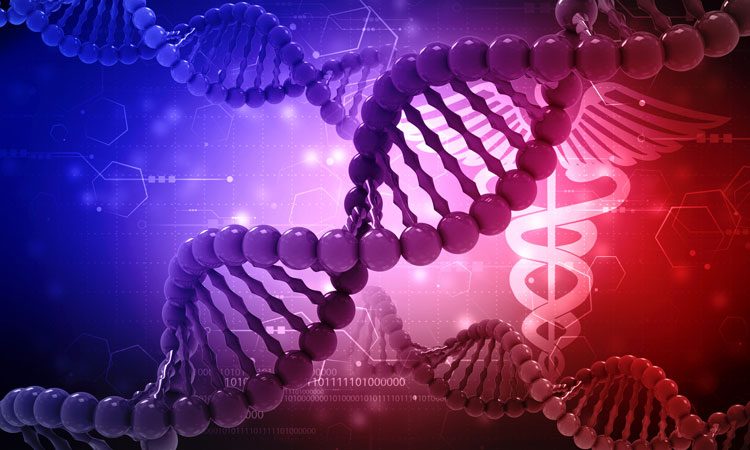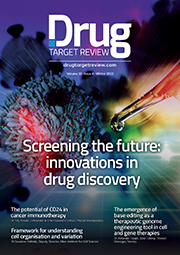Metabolomics in drug and biomarker discovery
Posted: 25 September 2018 | Giuseppe Astarita - Denali Therapeutics | No comments yet
Metabolomics is the state-of-the-art qualitative or quantitative analysis of metabolites present in biological samples. Since the majority of diseases are associated with metabolic alterations – either as a cause or result of the disease process – metabolomics is increasingly being used in drug and biomarker discovery.

Metabolites are essential components of every living organism, providing cellular energy as well as structural and signalling functions. For example, metabolites encompass biochemical classes such as nucleotides, amino acids, carbohydrates and lipids, which are the building blocks of DNA/RNA, proteins, glycogen and cellular membranes, respectively. Metabolites are both end products of metabolism (eg, enzymatic activities) and derive from the environment (eg, gut microbiota, diet, medications). Changes in the levels or composition of metabolites determine the phenotype of a biological system, which is associated with a specific physiological and pathological state.
Can we measure metabolites to assess health and disease?
In ancient times, metabolites in human samples were examined by taste or smell as part of a medical assessment. For example, diabetes was diagnosed by detecting a sweet taste to the urine. Over time there has been an exponential growth in our ability to use more sophisticated analytical approaches for the accurate measurement of an increasing number of metabolites in biological samples.
Over the last few decades, clinicians have routinely been measuring blood metabolites such as glucose to monitor diabetes; cholesterol to assess cardiovascular health; creatinine for renal disorders; and a panel of other metabolites to diagnose inborn errors of metabolism in newborns.
Today, technological advances are revolutionising the way we measure metabolites. We now have the capability to measure metabolites in biological samples hundreds of times faster than was possible a few decades ago. The resultant volume of information offers an unprecedented opportunity for a more in-depth description of complex biological systems, which may lead to unexpected scientific discoveries and expand our understanding of health and disease.
How is metabolomics being used in drug and biomarker discovery?
Metabolomics is becoming an indispensable research tool in academic, pharmaceutical and biotechnological sectors, to investigate the biology underlying disease or drug mechanisms and to identify novel therapeutic targets.
Metabolomics is also helping to provide a functional read-out for genetic diversity (genotypes, epigenetic regulation, mutations, and polymorphism) and the gut microbiome that have been associated with increased risk for many human diseases including cancer, cardiovascular and neurodegenerative diseases.
The identification of metabolites that are associated with disease development and progression may pave the way for the discovery of predictive, diagnostic, and prognostic biomarkers, and to monitor therapeutic outcomes.1
How to set up a metabolomics study?
Metabolomics analysis should always be considered as a team study, in which an interdisciplinary group of scientists (eg, analytical chemists, biologists, biomarker scientists, bioinformaticians, physicians and statisticians) pool their strengths and knowledge to create the most appropriate experimental design. Topics of discussion usually include the type and number of biological samples, treatment, dose and time point necessary to provide a meaningful answer to any scientific questions posed. A crucial part of this planning is the agreement on which pre-analytical and analytical requirements are needed for measuring reliable and reproducible concentrations of metabolites in biological samples.
Pre-analytical challenges in metabolomics
Pre-analytical steps need to be properly controlled to ensure that the metabolites measurements reflect as closely as possible the endogenous values. The levels and composition of metabolites may indeed change during collection and handling of biological samples due to ongoing enzymatic activities or exposure to oxygen, light or different micro-environments. Thus, as a prerequisite to ensure the validity of the entire study, researchers should follow validated protocols for pre-analytical steps that are created keeping the metabolomics requirements in mind.2-4
When dealing with the selection of subjects to include in the study, the most common variables to consider that may affect the levels of metabolites in a biological specimen include age, sex, body mass index, ethnicity, and current medications or dietary supplement intake. Such variables are usually accounted for when analysing and interpreting metabolomics data.
When dealing with the sample collection and handling steps, it is necessary to standardise the time of day for collection, fasting status, the procedure of collection, collection tubes, centrifugation steps before freezing the samples, freeze-thawed cycles, consumables and sample storage conditions. Poor practice may affect the robustness and reproducibility of acquired data, complicating data analysis and interpretation.
Analytical strategies for metabolomics
After taking account of the pre-analytical steps, the design of a metabolomics study should pay particular attention to the standardisation of the procedures for sample preparation and analysis, which contribute to the reproducibility and inter-laboratory comparison of metabolomics data.
A typical metabolomics experiment starts with a sample preparation step, which usually involves the extraction of the metabolites from the proteins and other sample matrix constituents present in the biological sample. Next, the complex mixture of metabolites present in the biological sample are separated using chromatography or directly analysed by a mass spectrometer detector. Mass spectrometry is the technology of choice for metabolomics. This is mostly due to its sensitivity and selectivity of analysis that allows measuring the numerous and diverse metabolites in biological samples.
The final step in the design of a metabolomic study presupposes the choice of the analytical approaches that are more appropriate for answering the scientific questions posed. Indeed, various analytical approaches may be used for metabolomic investigations: untargeted metabolomics, targeted metabolomics, fluxomics and imaging metabolomics.
Untargeted metabolomics
Untargeted metabolomics consists of the unbiased screening of as many metabolites as possible in a biological sample. Metabolic profiles are then compared between different groups (eg, healthy versus diseased, control versus treated, wild-type versus genetically modified) using various statistical tools. Any significant metabolic change is finally identified by searching against metabolomics databases. The outcome of such an unbiased approach is the generation of novel hypotheses, often unexpected, on the potential role of specific metabolites or metabolic pathways in disease and drug mechanisms, and their potential use as biomarkers.
The untargeted approach for metabolomics is mostly qualitative or semi-quantitative in nature and uses high resolution and high accuracy mass spectrometers. Particular attention should be paid to the randomisation of samples and the analysis of quality control samples to normalise for analytical variability. Results from untargeted analyses usually require further confirmation and validation using more quantitative and targeted metabolomics approaches.
Targeted metabolomics
Targeted metabolomics aims to quantify selected metabolites, often related to a specific metabolic pathway or biochemical class (eg, Krebs’s cycle metabolites, amino acids). Targeted metabolomics is routinely used in drug and biomarker discovery firstly to validate alterations in metabolites, which have been selected based on results from untargeted screenings or literature searches; secondly, to monitor biomarkers of disease, target engagement and efficacy; and finally, to measure with high sensitivity the levels of low abundance metabolites in biological samples.
Targeted analysis generates more quantitative and reproducible data than untargeted analysis. Usually, internal standards for selected metabolites of interest are spiked in the biological samples prior to sample preparation to normalise for variability in sample preparation and detection. Selected metabolites are then analysed using multiple-reaction monitoring transitions with triple-quadruple mass spectrometers.
A targeted metabolomics approach could be either semi quantitative or fully quantitative in nature. Semi-quantitative multiplexed assays allow high-throughput measurements of up to hundreds of selected metabolites using just a handful of internal standards. Such an approach is usually used in a discovery phase to generate hypotheses. Alterations in metabolites of interest are then further validated in larger cohorts using stable isotope-labelled internal standards for absolute quantification.
Fluxomics
Metabolism is a dynamic process and metabolites are continuously transformed as part of an intricate metabolic network of biochemical pathways. Stable isotope tracer-based metabolomics, also called fluxomics, uses stable isotope-labelled metabolites as tracers to follow their metabolic fate in biological systems. The concentration and labelling pattern of the labelled metabolites varies depending on how intracellular fluxes in metabolic pathways are regulated. Fluxomics is used in drug discovery to identify biochemical steps that are targeted by pharmacological or genetic manipulations, helping to unravel the mechanism of action of drugs or the role of genes in metabolism.5
Metabolomics imaging
Metabolomics imaging allows the visualisation of the spatial composition of metabolites within tissues. This approach bypasses the traditional sample preparation step consisting of homogenising the tissues for extracting the metabolites. Instead, a frozen tissue section is directly irradiated with a focused beam, such as a laser, or droplets of solvent. This process leads to the desorption of metabolites from the tissue in the form of ions, which can then be guided into a mass spectrometer. Computational processing of the data acquired pixel by pixel allows the generation of topographic maps of molecular composition, offering a form of molecular histology.
Metabolomics imaging is used in drug discovery to determine the spatial distribution and composition of endogenous metabolites, as well as to investigate the absorption, distribution, and metabolism of drugs in sub-regions of animal tissues.6
Conclusions and future directions
Metabolomics is a powerful research tool currently being applied to various aspects of drug and biomarker discovery. The identification of changes in metabolic profiles can shed light on mechanisms of diseases and drug actions, as well as provide useful diagnostic, prognostic and risk factor biomarkers.
Integrating metabolomics with other ’omics technologies, including genomics and microbiomics, will significantly improve our understanding of health and disease. Metabolomics information will play an increasingly important role in the risk stratification of disease and in precision medicine to allow patient selection and the customisation of an individual’s medical treatment based on specific metabolic profiles.
Biography
Giuseppe Astarita leads the metabolomics group at Denali Therapeutics, South San Francisco, CA, USA. During his 20-year career, Giuseppe has helped with the setup of state-of-the-art mass spectrometry facilities and know-how transfer for the analysis of lipids and metabolites in both academia and industry. By developing novel strategies and approaches for metabolomics and lipidomics, he applies the latest technologies to the study of health and disease. His work appears in over 70 peer-reviewed scientific publications and book chapters, which have been cited more than 6,000 times. Giuseppe is an inventor in 16 patents. He teaches short courses in metabolomics and lipidomics.
REFERENCES
- Wishart DS. Emerging applications of metabolomics in drug discovery and precision medicine. Nat Rev Drug Discov 15, 473-484 (2016).
- Beger RD, et al. Metabolomics enables precision medicine: “A White Paper, Community Perspective”. Metabolomics 12, 149 (2016).
- Yin P, Lehmann R, Xu G. Effects of pre-analytical processes on blood samples used in metabolomics studies. Anal Bioanal Chem 407, 4879-4892 (2015).
- Kirwan JA, et al. Preanalytical Processing and Biobanking Procedures of Biological Samples for Metabolomics Research: A White Paper, Community Perspective (for “Precision Medicine and Pharmacometabolomics Task Group”—The Metabolomics Society Initiative). Clinical Chemistry, clinchem. 2018.287045 (2018).
- Cascante M, Marin S. Metabolomics and fluxomics approaches. Essays in biochemistry 45, 67-82 (2008).
- Loden H, Shariatgorji M, Nilsson A, Andren PE. An introduction to MS imaging in drug discovery and development. Bioanalysis 7, 2621-2627 (2015).
The rest of this content is restricted - login or subscribe free to access
 Thank you for visiting our website. To access this content in full you'll need to login. It's completely free to subscribe, and in less than a minute you can continue reading. If you've already subscribed, great - just login.
Thank you for visiting our website. To access this content in full you'll need to login. It's completely free to subscribe, and in less than a minute you can continue reading. If you've already subscribed, great - just login.
Why subscribe? Join our growing community of thousands of industry professionals and gain access to:
- quarterly issues in print and/or digital format
- case studies, whitepapers, webinars and industry-leading content
- breaking news and features
- our extensive online archive of thousands of articles and years of past issues
- ...And it's all free!
Click here to Subscribe today Login here
Related topics
Biomarkers, Drug Discovery, Metabolomics







